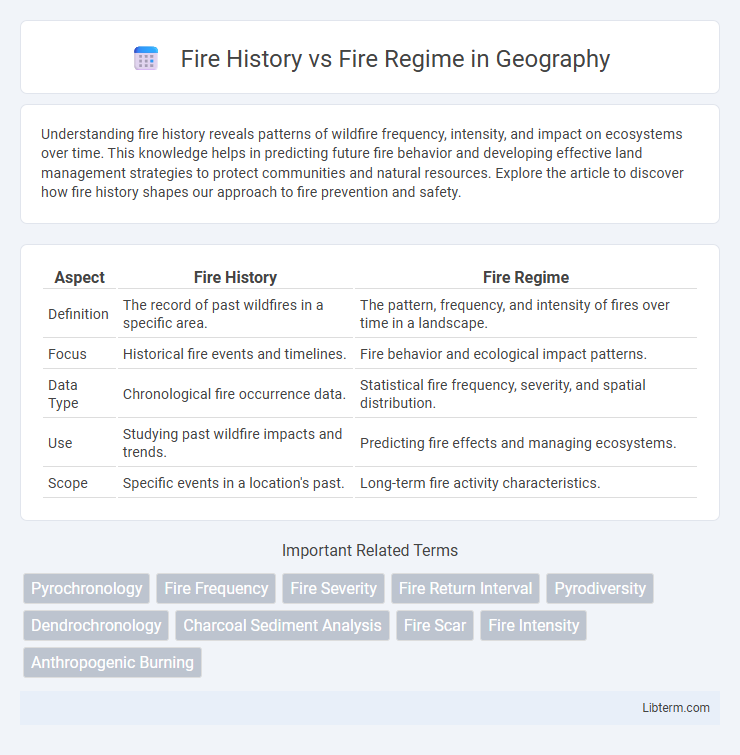Understanding fire history reveals patterns of wildfire frequency, intensity, and impact on ecosystems over time. This knowledge helps in predicting future fire behavior and developing effective land management strategies to protect communities and natural resources. Explore the article to discover how fire history shapes our approach to fire prevention and safety.
Table of Comparison
| Aspect | Fire History | Fire Regime |
|---|---|---|
| Definition | The record of past wildfires in a specific area. | The pattern, frequency, and intensity of fires over time in a landscape. |
| Focus | Historical fire events and timelines. | Fire behavior and ecological impact patterns. |
| Data Type | Chronological fire occurrence data. | Statistical fire frequency, severity, and spatial distribution. |
| Use | Studying past wildfire impacts and trends. | Predicting fire effects and managing ecosystems. |
| Scope | Specific events in a location's past. | Long-term fire activity characteristics. |
Introduction to Fire History and Fire Regime
Fire history documents past wildfire occurrences, frequency, size, and intensity within a specific region, providing vital data for understanding long-term ecological changes. Fire regime characterizes the typical patterns of fire behavior, including fire frequency, seasonality, and severity that shape an ecosystem over time. Analyzing fire history helps define fire regimes, essential for effective wildfire management and ecological restoration strategies.
Defining Fire History: Key Concepts
Fire history refers to the chronological record of wildfires in a specific area, documenting the frequency, intensity, and spatial distribution of past fires. Key concepts include fire scars, charcoal deposits, and historical records that help reconstruct fire occurrence and behavior over time. Understanding fire history provides insights into natural fire patterns, ecosystem responses, and guides effective land management and restoration strategies.
Understanding Fire Regimes: Core Elements
Fire regimes encompass the patterns, frequency, intensity, and types of fires occurring in a specific area over time, offering a comprehensive framework beyond mere fire history. Core elements of fire regimes include fire frequency, fire severity, and spatial extent, which together influence ecosystem processes and vegetation dynamics. Understanding these elements aids in predicting fire behavior, managing landscapes, and restoring fire-adapted ecosystems effectively.
Differences Between Fire History and Fire Regime
Fire history refers to the chronological record of past fires in a specific area, including their frequency, intensity, and spatial extent, while fire regime encompasses the broader patterns and ecological roles of fire over long periods that shape landscapes and ecosystems. Fire history provides detailed, event-specific data obtained from physical evidence such as tree rings or charcoal layers, whereas fire regime integrates this information to understand natural fire cycles and their influence on vegetation types and wildlife habitats. Differences between fire history and fire regime lie in their scale and purpose: fire history focuses on individual fire events and timelines, and fire regime addresses the overarching patterns and ecological impacts of fire in an ecosystem.
Methods for Studying Fire History
Fire history methods include dendrochronology, sediment charcoal analysis, and historical documents, which provide temporal and spatial records of past fire events. Fire regime studies combine these methods with fire severity, frequency, and seasonality data to understand patterns influencing ecosystem dynamics. Advanced remote sensing and GIS technologies enhance fire history reconstruction by mapping fire scars and burn perimeters across landscapes.
Techniques for Analyzing Fire Regimes
Techniques for analyzing fire regimes include dendrochronology, remote sensing, and sediment charcoal analysis, each providing insights into fire frequency, intensity, and spatial patterns over time. Dendrochronology tracks fire scars on tree rings, revealing historical fire events and intervals, while remote sensing utilizes satellite imagery to monitor recent and ongoing fires. Sediment charcoal analysis gathers data on ancient fire activity by examining charcoal deposits in soil layers, offering a long-term perspective essential for understanding ecological impacts and fire management strategies.
Importance of Fire History in Ecosystem Management
Fire history provides crucial data on the frequency, intensity, and seasonality of past fires, enabling accurate reconstruction of ecological patterns and processes. Understanding historical fire events helps ecosystem managers develop fire regimes that maintain biodiversity, support habitat resilience, and reduce the risk of catastrophic wildfires. Integrating fire history into fire regime planning ensures adaptive management strategies that align with natural disturbance cycles and promote long-term ecosystem health.
The Role of Fire Regimes in Landscape Dynamics
Fire regimes, characterized by the frequency, intensity, seasonality, and size of fires, play a crucial role in shaping landscape dynamics by influencing vegetation patterns, soil properties, and habitat diversity. Understanding fire history provides data on past fire events, but analyzing fire regimes offers insights into the ecological processes driving succession, nutrient cycling, and ecosystem resilience. Effective landscape management depends on integrating fire regime knowledge to maintain biodiversity, reduce wildfire risks, and support sustainable land use.
Linking Fire History to Fire Management Practices
Fire history provides detailed records of past fire events, including frequency, intensity, and spatial patterns, which are essential for understanding fire regimes that characterize typical fire behavior in specific ecosystems. Linking fire history to fire management practices enables land managers to design strategies that align with natural fire cycles, improving ecosystem resilience and reducing wildfire risks. Integrating fire history data into fire regime assessments supports adaptive management approaches that optimize controlled burns, fuel treatments, and restoration efforts.
Future Directions in Fire Science Research
Future directions in fire science research emphasize integrating fire history data with dynamic fire regime models to predict ecosystem responses under climate change scenarios. Advancements in remote sensing and machine learning enable detailed reconstruction of historical fire patterns, enhancing the accuracy of fire regime characterization across diverse biomes. Emphasizing interdisciplinary approaches, researchers aim to link fire history with vegetation dynamics, carbon cycling, and socio-economic factors to inform adaptive fire management strategies.
Fire History Infographic

 libterm.com
libterm.com